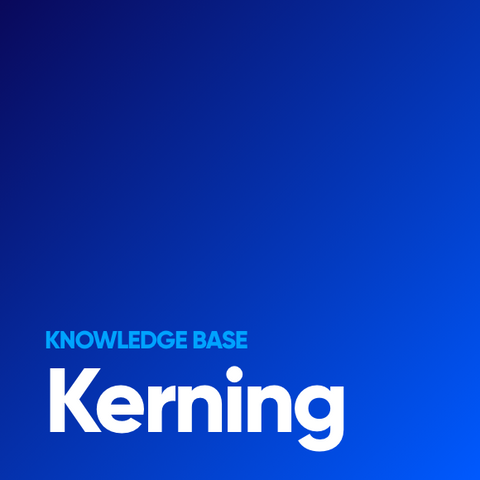Kerning: Crafting Typography Harmony
In the realm of typography and graphic design, there exists a meticulous craft that often goes unnoticed but plays a pivotal role in the readability and aesthetics of text—Kerning. Kerning isn't merely the adjustment of spaces between characters; it's the art of creating perfect harmony within fonts. In this comprehensive exploration, we will delve into the world of Kerning, unravel its significance, explore its applications, and appreciate its crucial role in typography and design.
Unveiling the Essence of Kerning
At its core, Kerning is fine-tuning the spacing between characters in a typeface. It goes beyond the default spacing provided by fonts to ensure that every letter, number, and symbol aligns harmoniously. The essence of Kerning lies in its ability to enhance the legibility and visual appeal of text, making it easier to read and aesthetically pleasing.
Why is Kerning so important?
Kerning is the invisible force ensuring text is easily read and visually pleasing. Poor kerning can lead to text that is jumbled and difficult to decipher.
Decoding the Significance
The significance of Kerning in the realm of typography and graphic design cannot be overstated:
-
Readability: Proper kerning enhances the readability of text by ensuring that characters are spaced in a way that doesn't cause visual confusion.
-
Aesthetics: Kerning improves the visual appeal of text by creating a harmonious flow and eliminating awkward gaps or collisions between characters.
-
Brand Identity: In branding, custom kerning can help create a unique typographic identity for a brand, making it instantly recognizable.
-
Legibility: Kerning is especially critical for fonts used in signage, print, and digital media, where text must be legible at various sizes and distances.
-
Typography Nuance: Kerning allows designers to fine-tune typography, giving them control over the character spacing to achieve specific design objectives.
Applications of Kerning
Kerning finds applications in a variety of design fields:
-
Print Design: Kerning is crucial in print design, where precise character spacing is necessary for publications, magazines, posters, and packaging.
-
Digital Design: In web and app design, kerning ensures that text is legible and visually pleasing across various screen sizes and devices.
-
Logo Design: Custom kerning is often used in design to create unique and memorable typographic logos.
-
Signage: Kerning is essential for signage design, as it ensures that text can be read from a distance and at varying angles.
-
Editorial Layout: In book and magazine layout, kerning contributes to the overall typographic quality of the publication.
Creating Effective Kerning
To achieve effective kerning, consider the following strategies:
-
Use Appropriate Tools: Utilize professional design software with kerning features that allow you to adjust character spacing with precision.
-
Optical Adjustment: Trust your eye. Sometimes, adjusting kerning visually can lead to better results than relying solely on metrics.
-
Contextual Awareness: Pay attention to the context in which the text will be used. Kerning requirements may vary depending on the medium and viewing distance.
-
Pairing Fonts: When combining multiple fonts in a design, ensure that the kerning between them is consistent for a cohesive and polished look.
-
User Testing: In digital design, conduct user testing to ensure the kerning is effective across various devices and screen sizes.
Celebrating the Impact of Kerning
The impact of Kerning in the realm of typography and design is transformative:
-
Enhanced Readability: Kerning enhances the readability of text, ensuring that characters flow smoothly and are easily distinguishable.
-
Aesthetic Appeal: Proper kerning contributes to the aesthetic appeal of text, making it visually pleasing and harmonious.
-
Brand Identity: In branding, kerning helps create a distinct typographic identity that sets a brand apart.
-
Legibility Across Media: Kerning ensures that text remains legible across print and digital media, from books to websites.
-
Typography Control: Kerning provides designers with control over typography, allowing them to fine-tune character spacing to achieve specific design goals.
Kerning Across Diverse Industries
Kerning is a universal typographic principle applicable to a wide array of industries:
-
Advertising: Advertisers use kerning to create visually appealing and memorable ad copy.
-
Fashion: In the fashion industry, kerning designs typography for clothing labels, branding, and promotional materials.
-
Architecture: Signage and architectural design rely on kerning for legible and visually pleasing text in buildings and public spaces.
-
Film and Entertainment: Kerning is vital in film credits, movie posters, and entertainment branding.
-
Hospitality: The hospitality industry uses kerning for signage, menus, and branding to create an inviting and memorable experience.
The Future of Kerning
As the field of typography and design continues to evolve, the future of Kerning holds exciting possibilities:
-
Variable Fonts: Fonts allow for real-time kerning adjustments, making typography more responsive to various contexts.
-
Automation and AI: AI-driven tools and automation will assist designers in fine-tuning kerning more efficiently.
-
Multilingual Kerning: As global communication becomes more prevalent, kerning for diverse languages and scripts will be a critical consideration.
Harmonizing Typography
In the world of typography and graphic design, Kerning is the silent conductor who orchestrates the harmonious flow of characters. It is the art of crafting perfect letter spacing, ensuring that text is readable and visually pleasing. Kerning isn't just about adjusting spaces; it's about shaping how we perceive and interact with text. In typography, Kerning is an unsung hero, making text more than just words; it's a visual experience and a bridge to effective communication.

Kerning





